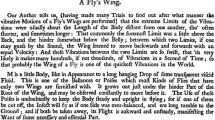Summary
-
1.
Recordings were made from single elements in the indirect flight muscles of the honey bee with the usual insulated metal electrodes uninsulated at the tip. With the “indifferent” electrode in the head few neighboring elements showed up. All recorded elements had random phase differences.
-
2.
In the dorsoventral (DV) muscles about 80% of the spikes are not followed by striking junctional components, 20% are. Practically all spikes from the dorsolongitudinal (DL) muscles have a junctional component following.
-
3.
The DV-muscles in the intact animal shorten linearily with increasing action potential frequency (Fig. 6). The DL-muscles are stretched slightly.
-
4.
Approximately 50 to 100 msec before the onset of oscillations the action potential frequency in both groups of muscles (DV and DL) increases to 30–60 Hz for 2 to 4 action potentials. The DV-muscles shorten (evidently isotonically) about 20 to 40 μ and start oscillations with a lengthening. An experiment performed by Boettiger (p. 438) might explain the events that start the oscillations. The oscillations end about 180 to 200 msec after the ending of the action potentials. The DV-muscles return to their resting length in the next 200 to 1,000 msec.
-
5.
The duration of the action potentials depends strongly on the temperature (Fig. 4).
-
6.
The wingbeat frequency increases with the action potential frequency (Fig. 10).
Zusammenfassung
-
1.
Bei Ableitung von Einzelelementen aus den indirekten Flugmuskeln der Honigbiene mit der indifferenten Elektrode im Kopf, erfaßt man mit den üblichen, bis zur Spitze isolierten Metallelektroden nur wenige Nachbarelemente. Alle erfaßten Elemente haben offensichtlich zufällige Phasenverschiebungen gegeneinander.
-
2.
In den dorsoventralen (DV) Muskeln folgen bei ca. 80% der Elemente keine auffälligen e.p.p. Komponenten, bei ca. 20% findet man eine e.p.p. Komponente. In den dorsolongitudinalen (DL) Muskeln hatten praktisch alle Elemente eine auffällige e.p.p. Komponente.
-
3.
Mit ansteigender Aktionspotential-Frequenz verkürzten sich die DV-Muskeln im intakten Tier linear mit der Frequenz (Abb. 6). Der DL-Muskel wurde etwas gedehnt.
-
4.
Etwa 50–100 msec vor dem Beginn von Oszillationen steigt die Aktionspotential-Frequenz in beiden Muskelgruppen (DV und DL) für 2–4 Aktionspotentiale auf 30–60 Hz. Der DV-Muskel verkürzt sich (offensichtlich isotonisch) um 20–40 μ und beginnt die Oszillationen mit einer Verlängerung. Ein Experiment von Boettiger, (S. 438) kann zur Erklärung der Vorgänge dienen, die die Oszillationen einleiten. Die Oszillationen enden 180–200 msec nach Aufhören der Aktionspotentiale. Die DV-Muskeln gehen in den nächsten 200–1000 msec auf die Ruhelänge zurück.
-
5.
Die Länge der Aktionspotentiale hängt stark von der Temperatur ab (Abb. 4).
-
6.
Die Flügelschlagfrequenz steigt mit der Aktionspotential-Frequenz (Abb. 10).
Similar content being viewed by others
References
Boettiger, E. G.: Triggering of the contractile process in insect fibrillar muscle. Physiological triggers (ed. T. H. Bullock), p. 103–116. Washington: American Physiological Society 1957.
Buchthal, F., T. Weis-Fogh, and P. Rosenfalk: Twitch contractions of isolated flight muscles of locusts. Acta physiol. scand. 39, 246–276 (1957).
Castillo, Del, J., G. Hoyle, and Xenia Machne: Neuromuscular transmission in a locust. J. Physiol. (Lond.) 121, 539–547 (1953).
Donaldson, P. E. K.: Electronic apparatus for biological research, p. 718. New York, N.Y.: Academic Press Inc. 1958.
Esch, H.: Über die Körpertemperaturen und den Wärmehaushalt von Apis mellifica. Z. vergl. Physiol. 43, 305–335 (1960).
—: Über die Schallerzeugung im Werbetanz der Honigbiene. Z. vergl. Physiol. 45, 1–11 (1961).
—: Die Bedeutung der Lauterzeugung für die Verständigung der stachellosen Bienen. Z. vergl. Physiol. 56, 199–220 (1967).
—, and D. Wilson: The sounds produced by flies and bees. Z. vergl. Physiol. 54, 256–267 (1967).
Pringle, J. W. S.: Insect flight, p. 132. Cambridge: University Press 1957.
—: The contractile mechanisms of insect fibrillar muscle (myofibrillar proteins). Progr. Biophys. Mol. Biol., vol. 17, p. 1–60, New York and London: Pergamon Press 1967.
Snodgrass, R. E.: Anatomy of the honey bee, p. 334. Ithaca, N.Y.: Comstock Publishing Associates, Cornell University Press 1956.
Wilson, D. M., and R. J. Wyman: Phasically unpatterned nervous control of dipteran flight. J. Ins. Physiol. 9, 859–865 (1963).
Author information
Authors and Affiliations
Additional information
Supported by the National Science Foundation, grant GB 6528.
Rights and permissions
About this article
Cite this article
Esch, H., Bastian, J. Mechanical and electrical activity in the indirect flight muscles of the honey bee. Zeitschrift für vergleichende Physiologie 58, 429–440 (1968). https://doi.org/10.1007/BF00343515
Received:
Issue Date:
DOI: https://doi.org/10.1007/BF00343515




